建筑风格介绍(英文)
中国各民族建筑风格与我的专业英文介绍PPT
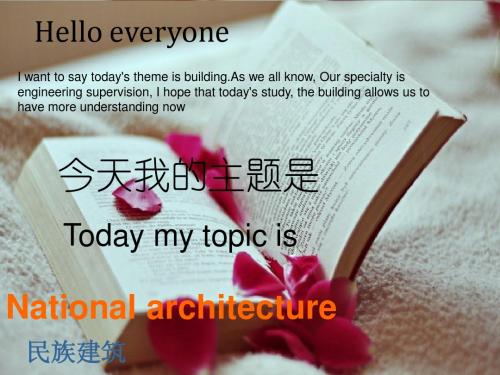
bamboo house傣族竹楼
bamboo house傣族竹楼
西 双 版 纳
西 双 版 纳
丽 江 古 城
• great beauty and enjoyment
• 丽江古城小桥流水的雅致和古朴光滑的青石板、石桥, 给人以极大的美感和享受
大理古城
• magnificent • flowers • a beautiful space.
Third, there is a clear code of conduct , according to that supervision. Supervision and supervision by both sides have been common code of conduct , it may reach a consensus in the supervision and supervision of the activity is to achieve common goals. Supervision must exercise the powers of supervision in accordance with the Code of Conduct , which is supervising the activities must be carried out by the Code of Conduct , to accept supervision 。 第三、有明确的行为准则,即监理的依据。监理者和被监理者双 方有共同的行为准则,才可能在监理和被监理的活动中达成共识,实 现共同的目标。监理者必须依据行为准则行使监理的权力,而被监理 者必须按行为准则进行活动,接受监理
监理是指一个执行者为了使某项活动达到一定要求,依据该项活动应遵 守的准则,对从事这项活动的人和组织的行为进行监督管理。包括监督、 控制、咨询、指导、服务等功能。 监理作为一项管理活动,具有以下特征: 首先,有明确的监理者,即监理活动的执行者。监理者是监理行为的 主体,一切监理活动都是由监理者ay today's theme is building.As we all know, Our specialty is engineering supervision, I hope that today's study, the building allows us to have more understanding now
建筑风格英文
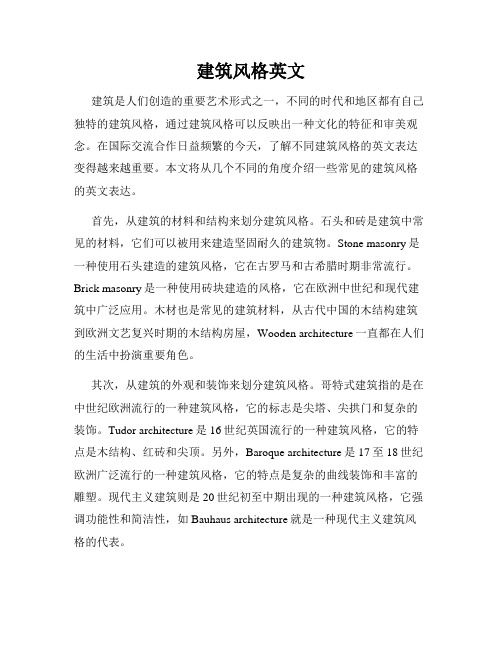
建筑风格英文建筑是人们创造的重要艺术形式之一,不同的时代和地区都有自己独特的建筑风格,通过建筑风格可以反映出一种文化的特征和审美观念。
在国际交流合作日益频繁的今天,了解不同建筑风格的英文表达变得越来越重要。
本文将从几个不同的角度介绍一些常见的建筑风格的英文表达。
首先,从建筑的材料和结构来划分建筑风格。
石头和砖是建筑中常见的材料,它们可以被用来建造坚固耐久的建筑物。
Stone masonry是一种使用石头建造的建筑风格,它在古罗马和古希腊时期非常流行。
Brick masonry是一种使用砖块建造的风格,它在欧洲中世纪和现代建筑中广泛应用。
木材也是常见的建筑材料,从古代中国的木结构建筑到欧洲文艺复兴时期的木结构房屋,Wooden architecture一直都在人们的生活中扮演重要角色。
其次,从建筑的外观和装饰来划分建筑风格。
哥特式建筑指的是在中世纪欧洲流行的一种建筑风格,它的标志是尖塔、尖拱门和复杂的装饰。
Tudor architecture是16世纪英国流行的一种建筑风格,它的特点是木结构、红砖和尖顶。
另外,Baroque architecture是17至18世纪欧洲广泛流行的一种建筑风格,它的特点是复杂的曲线装饰和丰富的雕塑。
现代主义建筑则是20世纪初至中期出现的一种建筑风格,它强调功能性和简洁性,如Bauhaus architecture就是一种现代主义建筑风格的代表。
再次,从建筑的功能和用途来划分建筑风格。
Cathedral是指天主教教堂,它在欧洲中世纪非常盛行。
Palace是指宫殿,用来指代古代国王或皇后的居所。
另外,Skyscraper是用来形容摩天大楼的词语,它通常用于表示高层建筑。
而Museum则是指博物馆,用来展示艺术品和历史遗迹。
最后,从地域和文化背景来划分建筑风格。
Mediterranean architecture是指地中海地区的建筑风格,它融合了希腊和罗马的元素,包括白色墙壁、红瓦和花园。
西方建筑风格 英文版

宋柳 李黎彬
Content
• • • • • Byzantine architecture Gothic architecture Ancient Roman architecture Romantic architecture Baroque architecture
Faç ade of the church Santa Susanna This new architecture focuses on color, light and shadow, sculpture, and strong baroque characteristics.
Italy, Sicily, Syracuse, cathedral Santa Maria delle Colonne
意大利西西里的锡拉丘兹主教座堂
布拉格圣Nicolas教堂,典型的波希 米亚巴洛克
The Wilanów palace in Warsaw, Poland.
• 巴洛克建筑的特征包括:
• 宽阔的、有时是圆形的中殿取代了狭长的中殿 • 戏剧性地使用光线,强烈的光影对比,明暗对照效果(如 威尔腾堡修道院教堂),或依靠窗户实现均匀照明(如温 加滕修道院教堂) • 大量使用装饰品(通常是镀金、石膏或粉饰灰泥、大理石 或人造大理石) • 巨大尺度的天花板壁画 • 外部立面的显着特点是通常有戏剧性的中央突出部分 • 内部通常只是绘画与雕塑的框架(特别是后期巴洛克) • 错视画法般的虚幻效果,绘画与建筑的混合 • 在巴伐利亚、捷克、波兰和乌克兰巴洛克,普遍存在梨状 穹顶 • 天主教国家的圣母柱和圣三柱,通常因黑死病结束时的感 恩而兴建
德国Trier(特里尔)的选帝侯宫
著名建筑英文介绍简短带翻译
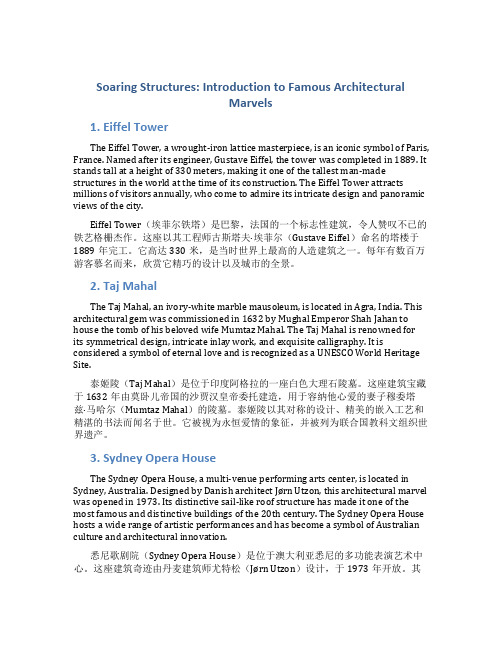
Soaring Structures: Introduction to Famous ArchitecturalMarvels1. Eiffel TowerThe Eiffel Tower, a wrought-iron lattice masterpiece, is an iconic symbol of Paris, France. Named after its engineer, Gustave Eiffel, the tower was completed in 1889. It stands tall at a height of 330 meters, making it one of the tallest man-made structures in the world at the time of its construction. The Eiffel Tower attracts millions of visitors annually, who come to admire its intricate design and panoramic views of the city.Eiffel Tower(埃菲尔铁塔)是巴黎,法国的一个标志性建筑,令人赞叹不已的铁艺格栅杰作。
这座以其工程师古斯塔夫·埃菲尔(Gustave Eiffel)命名的塔楼于1889年完工。
它高达330米,是当时世界上最高的人造建筑之一。
每年有数百万游客慕名而来,欣赏它精巧的设计以及城市的全景。
2. Taj MahalThe Taj Mahal, an ivory-white marble mausoleum, is located in Agra, India. This architectural gem was commissioned in 1632 by Mughal Emperor Shah Jahan to house the tomb of his beloved wife Mumtaz Mahal. The Taj Mahal is renowned for its symmetrical design, intricate inlay work, and exquisite calligraphy. It is considered a symbol of eternal love and is recognized as a UNESCO World Heritage Site.泰姬陵(Taj Mahal)是位于印度阿格拉的一座白色大理石陵墓。
英语作文介绍建筑物万能模板
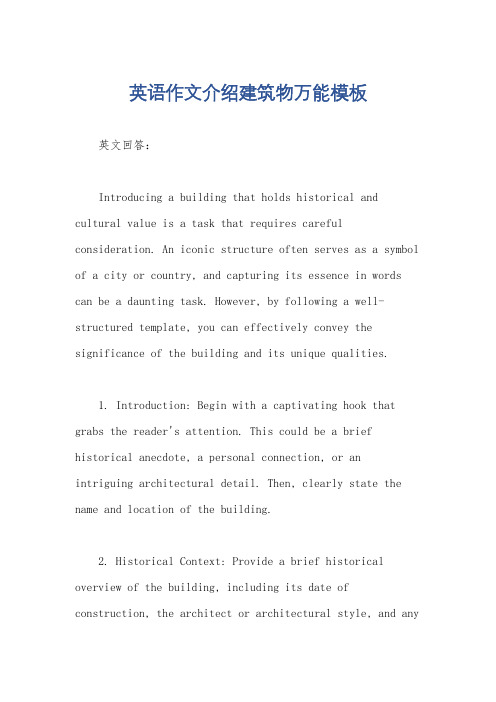
英语作文介绍建筑物万能模板英文回答:Introducing a building that holds historical and cultural value is a task that requires careful consideration. An iconic structure often serves as a symbol of a city or country, and capturing its essence in words can be a daunting task. However, by following a well-structured template, you can effectively convey the significance of the building and its unique qualities.1. Introduction: Begin with a captivating hook that grabs the reader's attention. This could be a brief historical anecdote, a personal connection, or anintriguing architectural detail. Then, clearly state the name and location of the building.2. Historical Context: Provide a brief historical overview of the building, including its date of construction, the architect or architectural style, and anysignificant events associated with it. Mention the original purpose of the building and how it has evolved over time.3. Architectural Features: Describe the architectural style and key features of the building. Discuss its structural elements, such as the foundation, walls, roof, and any distinctive arches, columns, or ornaments.Highlight the use of materials and the overall aesthetic appeal of the building.4. Cultural Significance: Explore the cultural significance of the building. Explain how it has influenced the city or country's identity, shaped its cultural traditions, and inspired artistic expression. Discuss any cultural events or rituals associated with the building and its role in the community.5. Symbolism and Impact: Discuss the symbolic meaning of the building. What does it represent for the city, country, or even the world? Explain how the building has impacted tourism, architecture, and other fields. Consider its role in shaping collective memory and fostering a senseof belonging.6. Conclusion: Summarize the main points of your essay and restate the significance of the building. Offer a personal reflection or thought-provoking question to leave a lasting impression on the reader.中文回答:介绍一座具有历史和文化价值的建筑,是一项需要认真考虑的任务。
英文建筑流派

Renaissance style
Florence Cathedral 佛罗伦萨大教堂
The most obvious features of Renaissance architecture is discarding the medieval Gothic style, and re-use the composition elements of ancient Greece and Roman column in the religious and secular buildings. Even fused the architectural style of the various regions together with the classical column. (文艺复兴建筑最明显的特 征是扬弃了中世纪时期的哥 特式建筑风格,而在宗教和 世俗建筑上重新采用古希腊 罗马时期的柱式构图要素。 甚至将各个地区的建筑风格 同古典柱式融合一起。)
UN building
Bauhaus building 包豪斯校舍(格罗皮乌斯)
Post-modern style
Portland City Hall 波特兰市政厅
Sydney Opera House 悉尼歌剧院
The post-modern architecture is the building after the general term for all schools. U.S. architecter Stern's theory: postmodern architecture has three characteristics: use of decoration; a symbolic or metaphorical; integration with the existing environment. (后现代建筑是指现代以后的各流派的建筑总称,美国建筑师斯特恩提出:后现代主 义建筑有三个特征:采用装饰;具有象征性或隐喻性;与现有环境融合。)
中国各民族建筑风格英文介绍

•Courtyard • building
•合院式建筑
•Bamboo house
•竹楼式
•Somethin g else
• 其他
中国各民族建筑风格英文介绍
Three workshops a screen wall 三坊一照壁
Bai nationality 白族
白族文化中开放性和 包容性的完 美体现
中国各民族建筑风格英文介绍
汉族Han nationality
• 1. Palaces
• Beijing Forbidden City and Imperial Palace • 紫禁城 故宫
• 2. Altars building
• the Temple of Heaven. 天坛
• 3. Bridge construction
中国各民族建筑风格英文介绍
•西双版纳
丽江古城
• great beauty and enjoyment
• 丽江古城小桥流水的雅致和古朴光滑的青石板、石桥 ,给人以极大的美感和享受
学习改变命运,知 识创造未来
中国各民族建筑风格英文介绍
学习改变命运,知 识创造未来
中国各民族建筑风格英文介绍
学习改变命运,知 识创造未来
中国各民族建筑风格英 文介绍
学习改变命运,知 识创造未来
2021年2月19日星期五
National architecture
• Han nationality 汉族 • Minority [maɪ'nɔrətɪ]少数民族 • Modern architecture 现代
学习改变命运,知 识创造未来
中国各民族建筑风格英文介绍
学习改变命运,知 识创造未来
徽派建筑英文描写作文
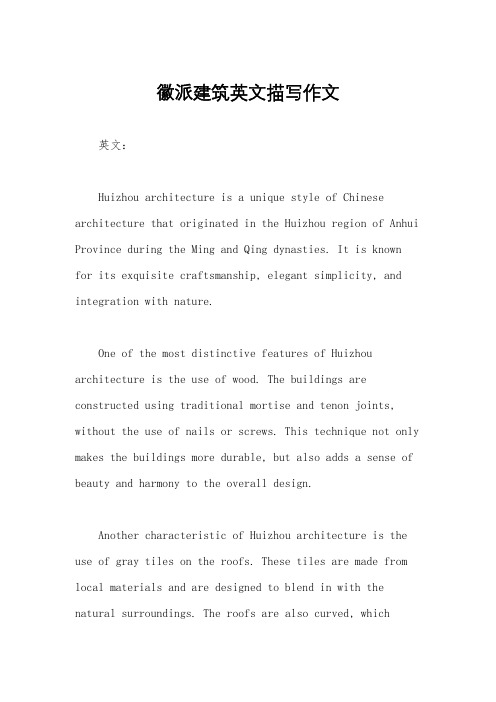
徽派建筑英文描写作文英文:Huizhou architecture is a unique style of Chinese architecture that originated in the Huizhou region of Anhui Province during the Ming and Qing dynasties. It is knownfor its exquisite craftsmanship, elegant simplicity, and integration with nature.One of the most distinctive features of Huizhou architecture is the use of wood. The buildings are constructed using traditional mortise and tenon joints, without the use of nails or screws. This technique not only makes the buildings more durable, but also adds a sense of beauty and harmony to the overall design.Another characteristic of Huizhou architecture is the use of gray tiles on the roofs. These tiles are made from local materials and are designed to blend in with the natural surroundings. The roofs are also curved, whichhelps to prevent rainwater from accumulating and causing damage to the structure.In addition, Huizhou architecture often incorporates elements of feng shui, such as the placement of the buildings and the use of certain colors and materials. For example, red is often used for doors and windows because it is believed to bring good luck and ward off evil spirits.Overall, Huizhou architecture is a testament to the ingenuity and creativity of Chinese craftsmen. It is a beautiful and functional style of architecture that continues to inspire architects and designers around the world.中文:徽派建筑是中国建筑的一种独特风格,起源于安徽省徽州地区的明清时期。
西方建筑 英文版 Western Architecture简介
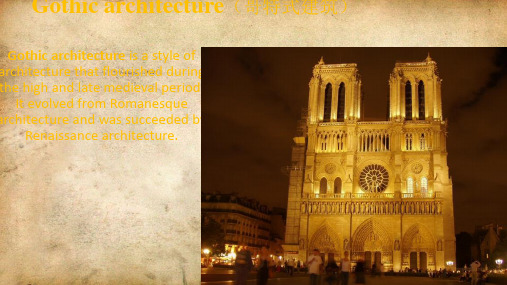
Baroque architecture(巴洛克式建筑)
Architectural features:
• broader naves (宽阔的中殿)
•strong light-and-shade contrasts (强
烈的光影对比)
Baroque architecture(巴洛克式建筑)
Architectural features:
Neoclassical architecture(新古典复兴建筑)
Architectural features:
• Focus on style(注重风格)
Pursue classical outline(追求古典轮 廓)
Neoclassical architecture(新古典复兴建筑)
Architectural features: • emphasize decorative effect(注重装饰效果)
(充满欢乐气氛)
Baroque architecture(巴洛克式建筑)
Represent building
Roman Jesus Church(罗马耶稣会教堂)
Neoclassical architecture(新古典复兴建筑)
Neoclassical architecture is an architectural style produced by the neoclassical movement that began in the mid-18th century, manifested both in its details as a reaction against the Rococo style of naturalistic ornament, and in its architectural formulas as an outgrowth of some classicizing features of Late Baroque.
英文作文住宅风格怎么写

英文作文住宅风格怎么写英文回答:The architectural style of a home is a distinctive set of design characteristics that define its overall appearance and aesthetics. It encompasses various elements such as structural form, rooflines, windows, doors,exterior cladding, and decorative details. Architectural styles have evolved over time, influenced by cultural, geographical, and historical factors. Here are some of the most common and recognizable architectural styles:1. Traditional Styles:Georgian: Symmetrical, rectangular shape with a hipped or gable roof, pedimented doorway, and large windows with shutters.Victorian: Ornate and eclectic, with asymmetrical lines, a steeply pitched roof with dormers, bay windows,and decorative trim.Craftsman: Emphasis on natural materials, simple lines, and handcrafted details, with low-pitched gabled roofs, overhanging eaves, and exposed rafters.2. Modern Styles:Modernist: Clean lines, geometric shapes, and a lackof ornamentation, with flat roofs, large windows, and open floor plans.Contemporary: Continuously evolving, with a focus on sustainability, energy efficiency, and innovative materials, often featuring unique rooflines, asymmetrical shapes, and expansive windows.Mid-Century Modern: Inspired by post-war optimism,with clean lines, open spaces, and floor-to-ceiling windows that blur the boundaries between indoor and outdoor.3. Mediterranean Styles:Spanish Colonial: Arched doorways and windows, stucco walls, tile roofs, and wrought-iron balconies, reminiscent of Spanish architecture.Tuscan: Inspired by Italian farmhouses, with stone or brick walls, arched windows and doorways, and terracotta tile roofs.Mediterranean Revival: A fusion of Spanish Colonial and Italian elements, with whitewashed walls, wrought-iron balconies, and terracotta tiles.4. Other Styles:Cape Cod: Typically a small, rectangular house with a sloped roof, central chimney, and white clapboard siding.Tudor: Asymmetry, steeply pitched roofs with exposed rafters, half-timbering, and leaded glass windows.Gothic: Pointed arches, ribbed vaults, and stained-glass windows, often seen in cathedrals and churches.The choice of architectural style for a home is a personal one, influenced by factors such as the homeowner's taste, the surrounding environment, and the intended use of the space. Different styles evoke different moods and atmospheres, from the grandeur of Georgian mansions to the cozy charm of Craftsman bungalows.中文回答:住宅风格是指住宅在外观和美学上具有的独特设计特征集合。
建筑特点描述英语作文
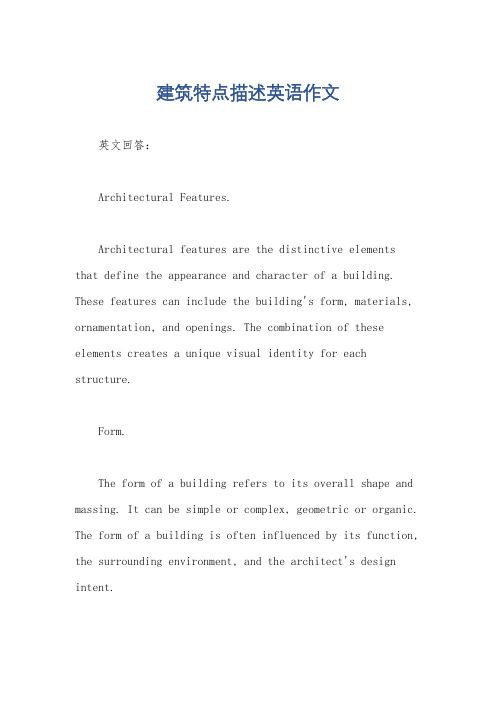
建筑特点描述英语作文英文回答:Architectural Features.Architectural features are the distinctive elementsthat define the appearance and character of a building. These features can include the building's form, materials, ornamentation, and openings. The combination of these elements creates a unique visual identity for each structure.Form.The form of a building refers to its overall shape and massing. It can be simple or complex, geometric or organic. The form of a building is often influenced by its function, the surrounding environment, and the architect's design intent.Materials.The materials used in a building's construction have a significant impact on its appearance and durability. Common building materials include stone, brick, wood, glass, and metal. The choice of materials can be influenced by cost, availability, and the desired aesthetic effect.Ornamentation.Ornamentation is the use of decorative elements to enhance the appearance of a building. These elements can include moldings, carvings, statues, and other decorative details. Ornamentation can be used to create a variety of effects, from simple elegance to elaborate grandeur.Openings.Openings in a building, such as windows and doors, allow for light, ventilation, and access. The size, shape, and placement of openings can have a significant impact on the building's appearance and function. Openings can bedesigned to provide natural light, create visual interest, and facilitate movement through the building.Historical and Cultural Influences.Architectural features are often influenced by historical and cultural factors. Different architectural styles have emerged throughout history, each with its own characteristic features. These styles can be influenced by geographical location, climate, religious beliefs, and social customs.Sustainability and Energy Efficiency.In contemporary architecture, there is a growing emphasis on sustainability and energy efficiency. Architectural features such as passive solar design, natural ventilation, and energy-efficient materials are being incorporated into buildings to reduce their environmental impact.中文回答:建筑特征描述。
探索中国多元地域的建筑风貌:一种英文阐述

探索中国多元地域的建筑风貌:一种英文阐述In the vast expanse of China, a tapestry of architectural styles weaves a mesmerizing narrative, reflecting the nation's rich history, cultural heritage, and geographical diversity. From the majestic Forbidden City in Beijing to the intricate courtyard houses in Suzhou, each region has its unique architectural fingerprint that tells a story of time, craftsmanship, and regional identity.Firstly, let's delve into Beijing, the epicenter of Chinese imperial history. The Forbidden City, a UNESCO World Heritage Site, stands as a testament to the grandeur of the Ming and Qing dynasties. Its ornate red roofs, intricate carvings, and the use of auspicious symbols showcase the principles of feng shui, a holistic approach to architecture. In contrast, the city's hutongs, narrow alleys lined with traditional courtyard dwellings, exemplify theclose-knit community spirit and the vernacular architecture of northern China.Moving southwards, we encounter the water towns of Jiangnan, like Suzhou. Here, the delicate and elegant classical gardens, adorned with rock formations, bridges, and lotus ponds, embody therefined taste of the literati class. The white-washed walls, black-tiled roofs, and wooden structures harmoniously blend with their natural surroundings, creating a tranquil oasis amidst urban sprawl.The Tibetan plateau adds another layer of diversity, with its iconic monasteries such as Lhasa's Potala Palace. Constructed with stone and wood, these structures reflect the harmonious fusion of Tibetan Buddhism and traditional Tibetan architecture. The vibrant murals and intricate carvings tell tales of deities and mythical beings, while the flat roofs accommodate prayer flags, a symbol of spiritual communication.In the southwest, Yunnan Province showcases the ethnic minority influences. The Bai terraced rice fields not only provide sustenance but also house traditional dwellings with wooden frames and brightly painted facades, a testament to the region's agricultural culture. The Bai villages, like Dali, reveal unique architecture combining Han, Tibetan, and Southeast Asian elements.Lastly, the coastal cities like Shanghai and Guangzhou offer a modern twist on traditional styles. Skyscrapers like the OrientalPearl Tower coexist with restored colonial-era buildings, exemplifying the city's past-meets-present narrative. Meanwhile, the Cantonese-style architecture, characterized by verandas and open courtyards, speaks of the region's maritime trading history.In conclusion, China's architectural landscape is a kaleidoscope of styles that resonate with the nation's historical, cultural, and geographical diversity. Each region's buildings, whether ancient or contemporary, stand as a mirror, reflecting the local traditions, climate, and aspirations. This rich tapestry of architectural wonders invites us to appreciate the depth and beauty of China's built environment, reminding us of the enduring legacy of human ingenuity and cultural expression.中文翻译:在中国这片广袤的土地上,一座座建筑如同一幅幅画卷,展示了丰富的历史、文化传统和地理多样性。
客家土楼英文介绍
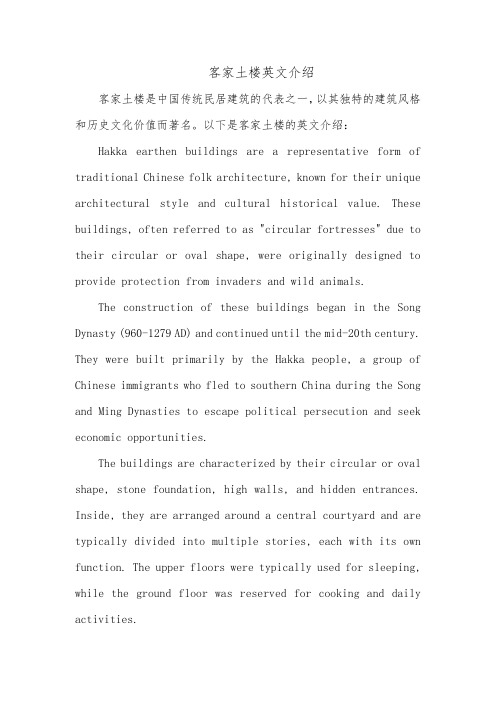
客家土楼英文介绍客家土楼是中国传统民居建筑的代表之一,以其独特的建筑风格和历史文化价值而著名。
以下是客家土楼的英文介绍:Hakka earthen buildings are a representative form of traditional Chinese folk architecture, known for their unique architectural style and cultural historical value. These buildings, often referred to as "circular fortresses" due to their circular or oval shape, were originally designed to provide protection from invaders and wild animals.The construction of these buildings began in the Song Dynasty (960-1279 AD) and continued until the mid-20th century. They were built primarily by the Hakka people, a group of Chinese immigrants who fled to southern China during the Song and Ming Dynasties to escape political persecution and seek economic opportunities.The buildings are characterized by their circular or oval shape, stone foundation, high walls, and hidden entrances. Inside, they are arranged around a central courtyard and are typically divided into multiple stories, each with its own function. The upper floors were typically used for sleeping, while the ground floor was reserved for cooking and daily activities.Hakka earthen buildings are an important part of Chinese cultural heritage and have been designated as national cultural relics. In addition to their historical value, they also serve as a symbol of traditional Chinese culture and are an important part of many tourist itineraries in China.。
英文的建筑介绍
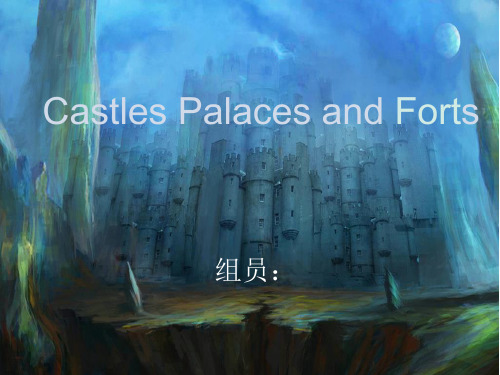
Palaces
• 古罗马建筑是古罗马人沿习亚平宁半岛上伊特鲁里亚人 的建筑技术,继承古希腊建筑成就,在建筑形制、技术 和艺术方面广泛创新 的一种建筑风格。古罗马建筑在公 元1-3世纪为极盛时期,达到西方古代建筑的高峰。
• 罗马建筑师把多力克式、艾奥尼亚式和科林斯式合而为 一,创造了“合成式”,也称罗马样式,集中体现在拱 门,圆顶、券拱结构上。简单的几何造型,巨大的规模 体量,厚重的石头材料给人心里以强大震撼。11-12世 纪,宗教盛行时期,受欧洲长方形会堂影响,加厚了罗 马式拱形建筑的墙壁,建出厚壁所产生的庄重美,教堂 建筑窗户少而使室内光线弱,室内装饰运用浮雕等具有 神秘感。
Palaces
奥古斯塔斯堡看上去 象一个巨大的田园。 这是科洛涅大主教奢 华的住所,也是法尔 肯拉斯特打猎时的落 脚地,是18世纪德国 涡卷式建筑的代表作 之一。
Domus Augustana 奥古斯塔斯堡
Palaces
Domus Augustana 奥古斯塔斯堡
德国布吕尔城内有两座深 受游人青睐的古堡--奥古 斯塔斯堡古堡和法尔肯拉 斯特古堡,它们是巴洛克 时代晚期和整个莱茵兰 (德国莱茵河西部)地区 举足轻重的建 筑。二者建 于德意志帝国克莱门斯-奥 古斯特选帝侯(德国有权 选举神圣罗马帝国皇帝的 诸侯)当政时期。1985年, 整个地区被联合国教科文 组织列为"世界自 然文化 遗产"。
Palaces
建筑特点
柱
拱
Palaces
哈德良行宫是古罗马的大型皇家 花园,它是罗马帝国的皇帝哈德 良为自己营造的一座人间伊甸园。 水是整个行宫建筑中最显著的主 题之一。水流从最南端引入,再 通过一个有管道和水塔组成的复 杂系统,最后流过整个别墅。每 一个建筑都有自己的用水设施, 包括大型水池和小型浴场水流系 统等一应俱全。在已知的水利建 筑中,有12个莲花形喷水泉,30 个单个喷泉,6个水帘洞,6个大 浴场,10个蓄水池,35个卫生间。 哈德良行宫是一座规模宏大的别 墅,其规模虽不及中国的圆明园, 但它在久远的古罗马文明中独树 一帜,一直是后世意大利花园风 格的典范,可以称得上是罗马的 “万园之园”Villa at Tivoli 古罗马哈德良皇帝宅邸 意大利
英语作文介绍建筑物万能模板
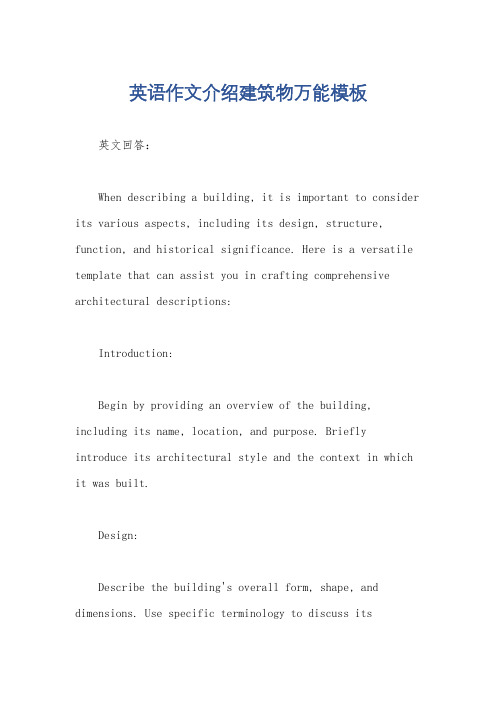
英语作文介绍建筑物万能模板英文回答:When describing a building, it is important to consider its various aspects, including its design, structure, function, and historical significance. Here is a versatile template that can assist you in crafting comprehensive architectural descriptions:Introduction:Begin by providing an overview of the building, including its name, location, and purpose. Briefly introduce its architectural style and the context in which it was built.Design:Describe the building's overall form, shape, and dimensions. Use specific terminology to discuss itsarchitectural features, such as columns, arches, windows, roofs, and ornamentation. Analyze the use of materials, textures, and colors in the design.Structure:Explain the structural system of the building, including the materials used and the techniques employed. Discuss the load-bearing elements, such as walls, columns, beams, and foundations. Analyze the relationship between the design and the structural elements.Function:Describe the intended purpose of the building, whether it is residential, commercial, religious, or cultural. Discuss the specific spaces within the building and how they relate to the overall function. Analyze the relationship between the design and the function.Historical Significance:If the building has historical significance, discussits role in the community or its influence on architecture. Provide information about the architect, the time period in which it was built, and any renovations or alterations it has undergone. Analyze the building's contribution to architectural history.Conclusion:Summarize the key aspects of the building's design, structure, function, and historical significance. Provide a personal reflection on the building's architectural merits and the impact it has on you.中文回答:建筑物描述万能模板。
英文介绍别墅作文
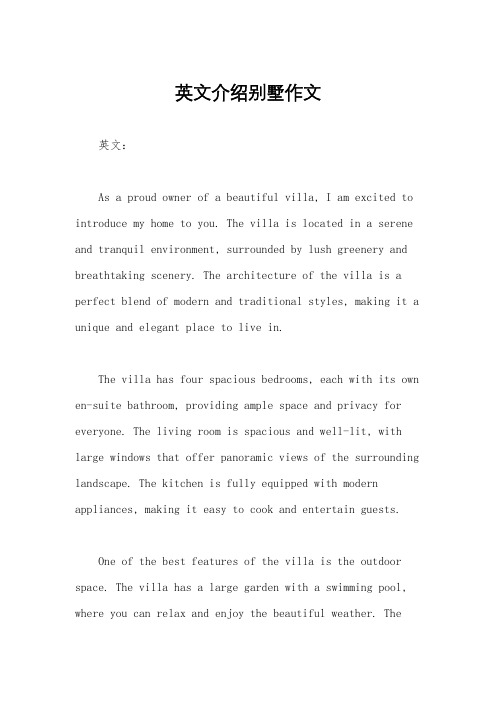
英文介绍别墅作文英文:As a proud owner of a beautiful villa, I am excited to introduce my home to you. The villa is located in a serene and tranquil environment, surrounded by lush greenery and breathtaking scenery. The architecture of the villa is a perfect blend of modern and traditional styles, making it a unique and elegant place to live in.The villa has four spacious bedrooms, each with its own en-suite bathroom, providing ample space and privacy for everyone. The living room is spacious and well-lit, with large windows that offer panoramic views of the surrounding landscape. The kitchen is fully equipped with modern appliances, making it easy to cook and entertain guests.One of the best features of the villa is the outdoor space. The villa has a large garden with a swimming pool, where you can relax and enjoy the beautiful weather. Thegarden also has a barbecue area, perfect for hosting outdoor parties and gatherings.Living in this villa has been a dream come true for me. It provides the perfect balance between luxury and comfort, making it a great place to call home.中文:作为一位美丽别墅的自豪业主,我很高兴向您介绍我的家。
